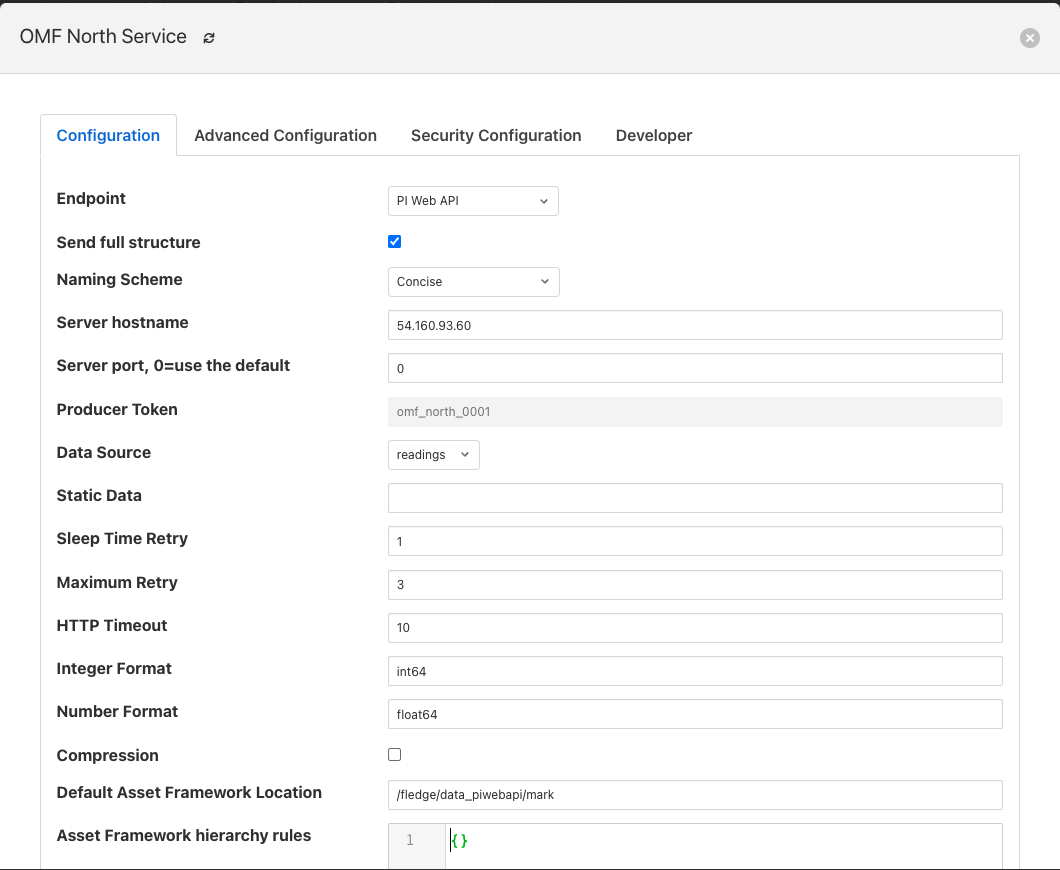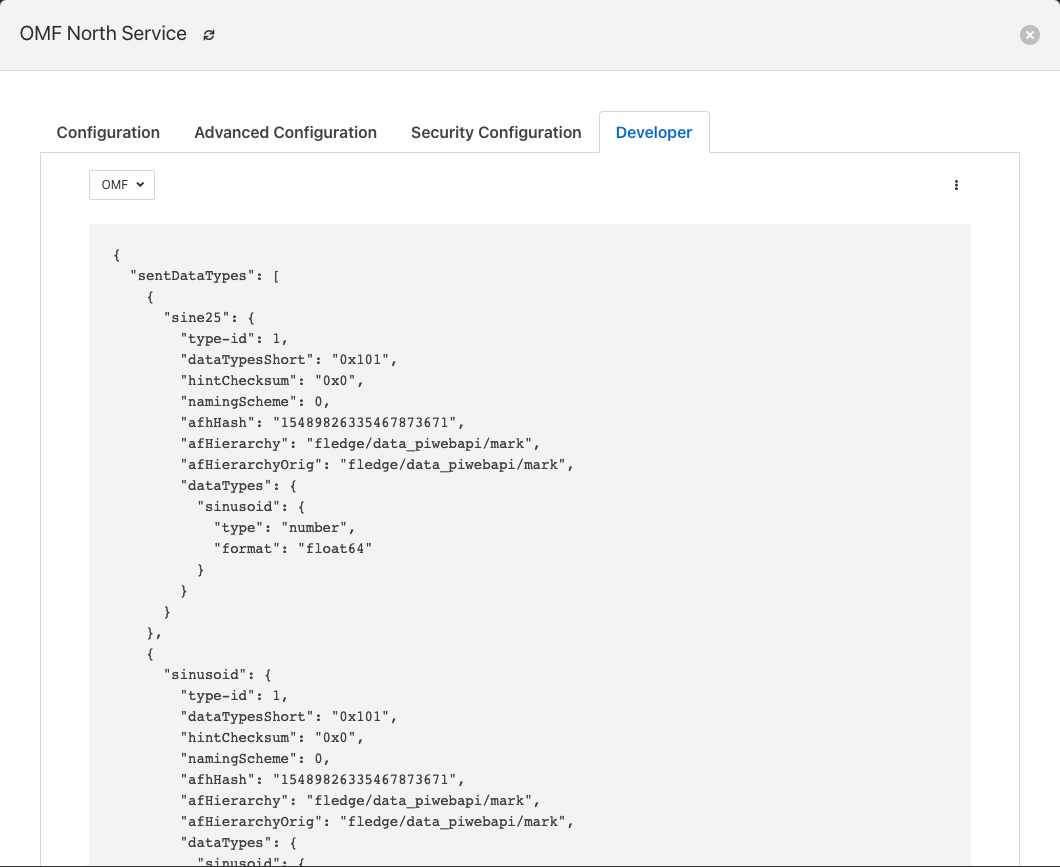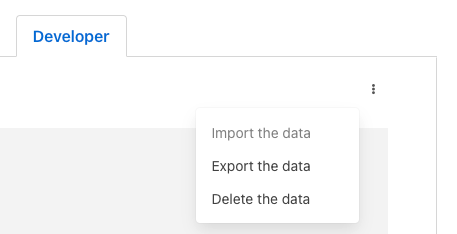Troubleshooting the PI Server integration¶
This section describes how to troubleshoot issues with the PI Server integration using the OMF North plugin. You should be running PI Web API 2019 SP1 (1.13.0.6518) or later.
Complex Types vs. Linked Types¶
This section describes the representation of Readings in the PI System using either Complex Types or Linked Types. Linked Types are highly recommended for new OMF North configurations.
Complex Types¶
When the OMF North plugin operates, it accepts Readings from the FogLAMP storage and uses them to create OMF Types, Containers and Data messages. In the initial release of the OMF North plugin, all Types were Complex Types. This means the Type would include data streams that represent all Datapoints in the Reading. If a Reading arrived later with the same asset name but with additional Datapoints, OMF would be forced to create a new Type and new Containers. Previously defined Containers would be abandoned.
Linked Types¶
In FogLAMP 2.1.0, support for OMF version 1.2 was introduced to the OMF North plugin. OMF 1.2 includes support for Linked Types. Each Datapoint becomes an AF Attribute mapped to a PI Point. OMF then links the AF Attribute to a parent AF Element to create a complete representation of the Reading in AF. A major advantage of Linked Types is that new Readings with additional Datapoints will not break any OMF Types. OMF will simply create a new AF Attribute and PI Point and link it to the existing parent AF Element.
Understanding Types when upgrading FogLAMP¶
When upgrading from a FogLAMP version prior to 2.1 where data had previously been sent to OMF, the plugin will continue to use the pre-OMF 1.2 Complex Types definitions to send data. This ensures that data will continue to be written to the same PI Points within the PI Server or other OMF end points. New OMF North instances will send data using the newer OMF 1.2 mechanism.
It is possible to create a new OMF North plugin instance that sends data using Complex Types (that is, pre-OMF 1.2 format) by turning on the option Complex Types in the Formats & Types tab of the plugin configuration. This is not recommended.
|
Log files¶
FogLAMP logs messages at error and warning levels by default, it is possible to increase the verbosity of messages logged to include information and debug messages also. This is done by altering the minimum log level setting for the north service or task. To change the minimal log level within the graphical user interface select the north service or task, click on the advanced settings link and then select a new minimal log level from the option list presented.
The name of the north instance should be used to extract just the logs about the PI Server integration, as in this example:
screenshot from the FogLAMP GUI

$ sudo cat /var/log/syslog | grep North_Readings_to_PI
Information Messages¶
If the minimum logging level is set to Information, the OMF North plugin will write messages that list the OMF Types, Containers and Links it creates. These messages can aid in understanding the artifacts created in the PI AF Server and the PI Data Archive and can help with troubleshooting. For example, if the Default Asset Framework Location is left at its default of /foglamp/data_piwebapi/default and the target AF Database is new, the following informational messages will be written to the log:
INFO: Created Type 16634532276179036866_foglamp_typeid
INFO: Created Element foglamp
INFO: Created Type 4258086130383245257_data_piwebapi_typeid
INFO: Created Element data_piwebapi
INFO: Created Link 16634532276179036866_foglamp to 4258086130383245257_data_piwebapi
INFO: Created Type 13582600746897291705_default_typeid
INFO: Created Element default
INFO: Created Link 4258086130383245257_data_piwebapi to 13582600746897291705_default
Types, Elements and Links¶
OMF Types appear in the AF Database as AF Element Templates. Templates can be viewed by running the PI System Explorer and navigating to the Library tab and expanding Element Templates. When an AF Element is created by OMF, its defining AF Template is displayed in the Template field of the General tab. This is the PI System Explorer view of the default AF Element:
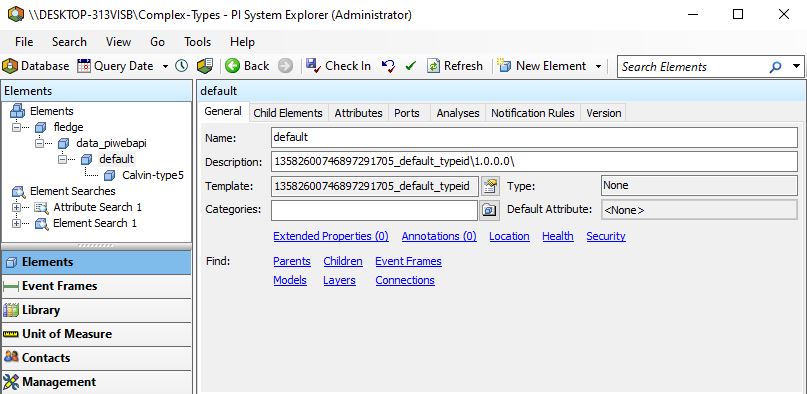
The Created Link messages show the creation of links between parent and child AF Elements thereby creating a hierarchy. The identifiers in the Created Link messages are the “index” values of the AF Elements. The index values can be viewed by clicking the Attributes tab for an AF Element in PI System Explorer. Look for the value of the Attribute “__id.” This is a view of the Attributes of the default AF Element:
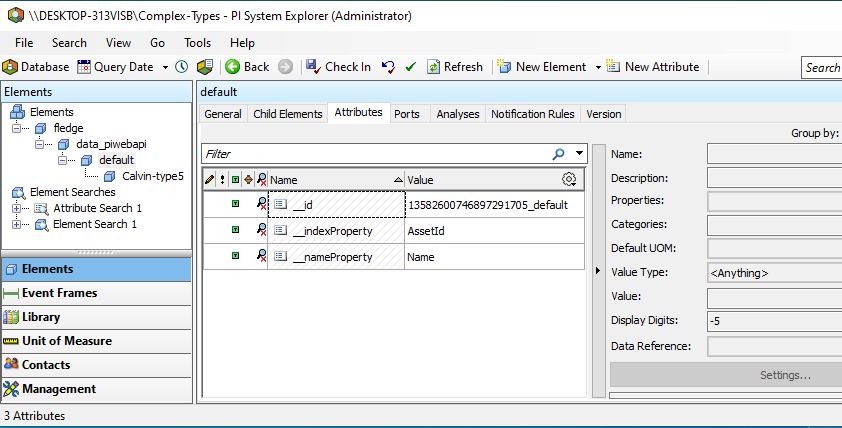
Containers¶
The Information messages logged for a Linked Types configuration are different from messages logged for a Complex Types configuration. Each Datapoint in a Reading will become a PI Point mapped to an AF Attribute for both configuration types but how they are organized is different.
Containers with Linked Types¶
With Linked Types, Containers become PI Points mapped to AF Attributes. Containers defined by Datapoints in a single Reading are created at once but additional Containers can be added later without breaking the configuration. For example, if a Reading with an asset named “Calvin” and 3 Datapoints named “random1” through “random3” is received by the plugin, the following message will be logged when the Containers are created:
INFO: Containers created: Calvin.random1,Calvin.random2,Calvin.random3
If at a later time another Reading named “Calvin” is received but with 4 Datapoints, a new message will be logged:
INFO: Containers confirmed: Calvin.random1,Calvin.random2,Calvin.random3,Calvin.random4
Strictly speaking, this message is not completely accurate. The first three Containers already exist so their presence is confirmed. The last Container (Calvin.random4) will be new.
The data type of the created PI Points and AF Attributes is not logged. You can check the data types by using the PI System Explorer to view the AF Attributes of the AF Element “Calvin” or by using PI System Management Tools to view the PI Points.
Containers with Complex Types¶
With Complex Types, Containers are defined by an OMF Type which will have one or more data streams in it. The Type will define the names and data types of the individual data streams. Types are created by the plugin to reflect a Reading and its Datapoints when the Reading is received by the plugin. When the Container is created, it is important to log its OMF Type as well:
INFO: Created Container (Type: A_13582600746897291705_default_2_Calvin_typename_measurement) 2measurement_Calvin
INFO: Created Element Calvin-type2
The data streams in this example will be Attributes of a new AF Element called “Calvin-type2.” To find the names of the individual data streams, check the definition of the AF Element Template “A_13582600746897291705_default_2_Calvin_typename_measurement” using PI System Explorer. You will see this AF Template has 3 AF Attributes named “random1” through “random3.” The names of the underlying PI Points will be the Container name from the logged message concatenated with the AF Attribute names separated by a dot (“.”). This means the PI Point names will be 2measurement_Calvin.random1, 2measurement_Calvin.random2 and 2measurement_Calvin.random3.
If at a later time another Reading named “Calvin” is received but with 4 Datapoints, the situation is much more complicated than for Linked Types. Once created, an OMF Type cannot be redefined to allow for additional data streams. The plugin will attempt to match the new Reading to the existing Type but this will fail:
ERROR: Error 409 creating Type A_13582600746897291705_default_2_Calvin_typename_sensor
ERROR: Error 409 creating Type A_13582600746897291705_default_2_Calvin_typename_measurement
ERROR: HTTP 409: Type conflict for Calvin (random1,random2,random3,random4). Creating a new Type: 2 messages
WARNING: Message 0 HTTP 200: Warning, The type with the supplied ID and version already exists.,
ERROR: Message 1 HTTP 409: Error, A type with the supplied ID and version already exists, but it does not match the supplied type.,
This is not a fatal error. The plugin will search for an existing Type that matches the definition of the newest Reading. It it can’t find one, it will create a new Type. The process should end with messages like these:
INFO: Created Type A_13582600746897291705_default_3_Calvin_typename_sensor
INFO: Created Type A_13582600746897291705_default_3_Calvin_typename_measurement
INFO: Created Container (Type: A_13582600746897291705_default_3_Calvin_typename_measurement) 3measurement_Calvin
INFO: Created Element Calvin-type3
This means the new PI Point names will be 3measurement_Calvin.random1, 3measurement_Calvin.random2 and 3measurement_Calvin.random3. Unfortunately, the previously-defined Containers with their underlying AF Attributes and PI Points cannot be reused.
Created vs. Confirmed¶
You may see the terms Created and Confirmed in the Information messages. They have specific meanings:
Created means an item did not exist in the PI Server and was created.
Confirmed means an item already exists and is correctly defined.
Note
The plugin makes this distinction by evaluating the HTTP return code from OMF POST calls. If an OMF POST call returns an HTTP return code of 200 (OK), it means an item already exists and is correctly defined. If an OMF POST call returns an HTTP return code of 201 (Created), it means a new item has been created.
Tracing File¶
It is possible to generate a detailed trace of all OMF messages POSTed to the AVEVA web server for troubleshooting purposes. This applies to all AVEVA OMF web server types: PI Web API, AVEVA CONNECT and Edge Data Store. To enable this feature, click the Enable Tracing checkbox on the OMF Basic tab.
Note
The Enable Tracing feature should be disabled in production environments. The omf.log file can grow to be quite large if the feature is left enabled.
The web server’s response to the POSTing of an OMF message is almost always a JSON document which is included in the omf.log trace file. You can temporarily configure PI Web API to include additional information for debugging purposes. To include debugging information, set the DebugMode boolean attribute to true in the PI Web API System Configuration. See the Configuration at runtime and Other security settings webpages on the AVEVA documentation website for instructions on how to do this. Debug information for OMF messages appears as a new Parameters array in an EventInfo object. For example, this JSON response snippet includes the identifier of the OMF Container and the name of the underlying PI Point:
"Parameters":[
{
"Name":"Container.Id",
"Value":"sinusoid.sinusoid"
},
{
"Name":"Container.TypeId",
"Value":"Double64"
},
{
"Name":"Container.TypeVersion",
"Value":"1.0.0.0"
},
{
"Name":"Property",
"Value":"Double64"
},
{
"Name":"PIPoint.Name",
"Value":"sinusoid.sinusoid"
}
]
Note
AVEVA notes that DebugMode should be used for troubleshooting only and should be disabled when you are done. In a production environment, the DebugMode attribute should be set to false to reduce vulnerability to cross-site scripting (XSS).
How to confirm that PI Web API is installed and running¶
Open the URL https://piserver_1/piwebapi in the browser (substituting piserver_1 with the name and address of your PI Server) to confirm that your server is reachable and that PI Web API is properly installed. If PI Web API is configured for Basic authentication, a prompt similar to the example shown below requesting entry of the user name and password will be displayed:
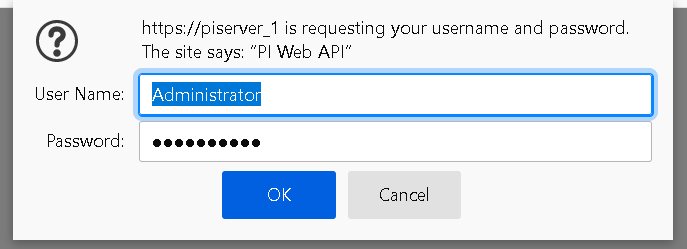
NOTE:
Enter the user name and password which you set in your FogLAMP configuration.
The PI Web API OMF plugin must be installed to allow the integration with FogLAMP, in this screenshot the 4th row shows the proper installation of the plugin:

Select the item System to verify the installed version:
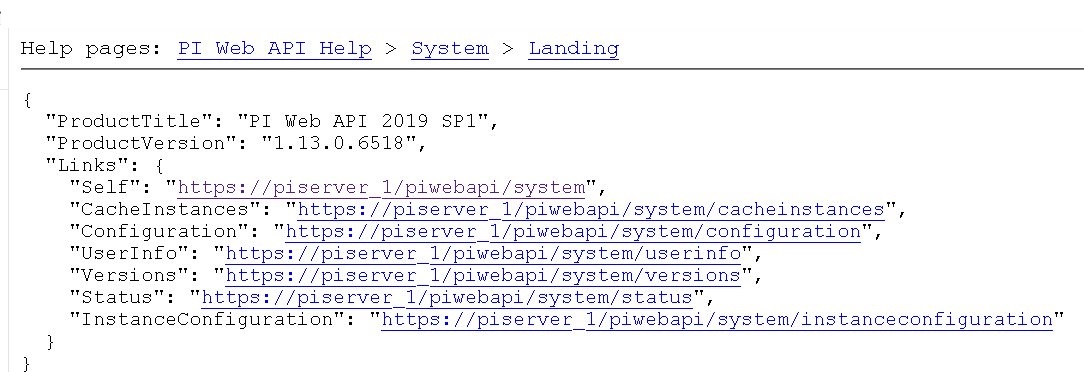
Commands to check PI Web API¶
Open the PI Web API URL and drill drown into the Data Archive and the Asset Framework hierarchies to verify the proper configuration on the PI Server side. Also confirm that the correct permissions have be granted to access these hierarchies.
Data Archive drill down
Following the path DataServers -> Points:


You should be able to browse the PI Points page and see your PI Points if some data was already sent:

Asset Framework drill down
Following the path AssetServers -> Select the Instance -> Select the proper Databases -> drill down into the AF hierarchy up to the required level -> Elements:

selecting the instance
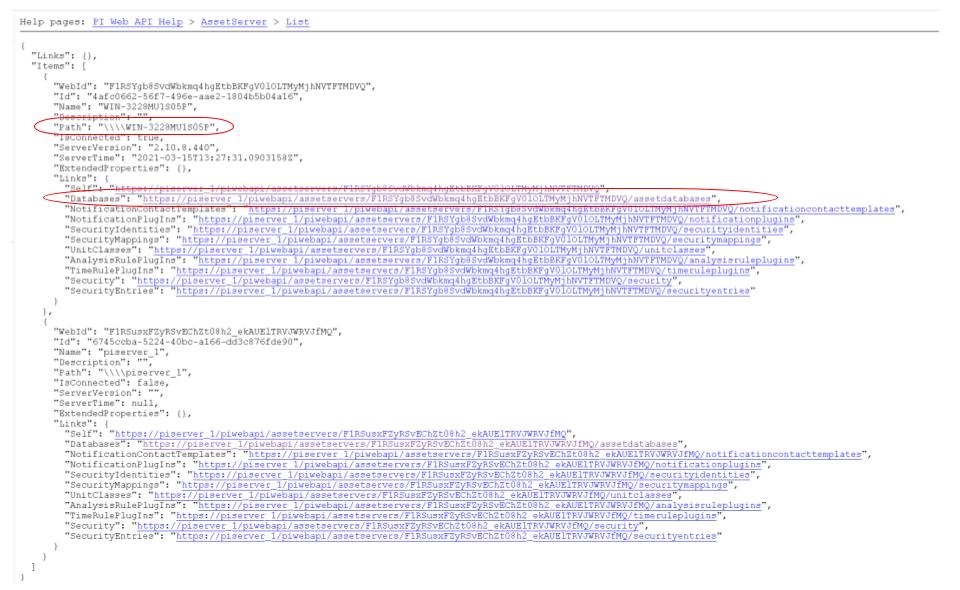
selecting the database
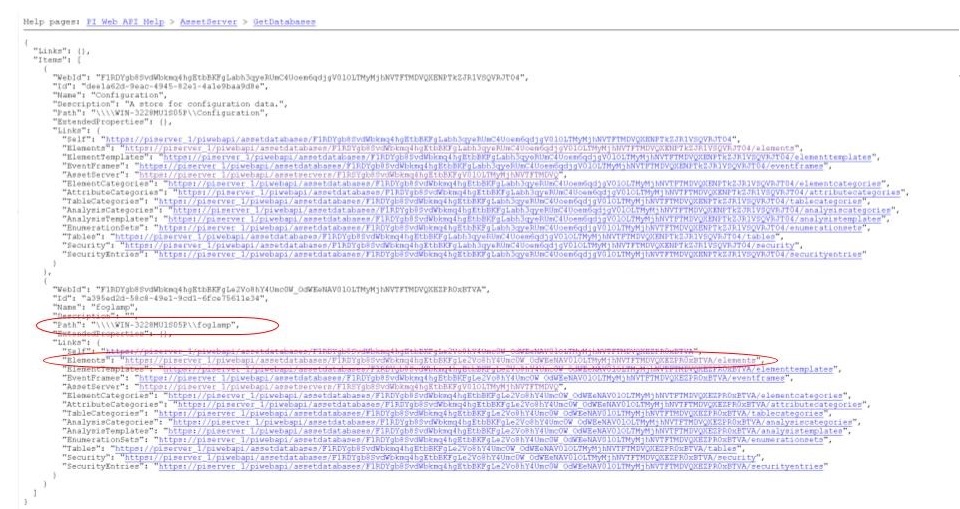
Proceed with the drill down operation up to the desired level/asset.
Understanding the OMF Data Cache¶
The PI Web API maintains two separate caches of PI Server data to maintain best performance: the PI System cache and the OMF cache. The PI System cache pools Asset Framework and Data Archive resources in support of PI Web API data access features. This cache is updated every 5 minutes. The OMF cache, on the other hand, caches Asset Framework resources created by OMF Type and Container messages. The cache is updated every 24 hours. The reason this cache is updated so infrequently is that AVEVA assumes that all AF Database items generated by OMF messages are only ever manipulated through OMF. See Data Caching on the AVEVA Documentation website for details.
You should never use other tools such as the PI System Explorer to edit or delete items in your AF Database that were created by OMF. If you do need to edit the AF Database directly to solve a problem, restart the PI Web API before restarting your OMF North plugin instance. The restarted PI Web API will have no OMF data cached.
Error Messages and Causes¶
This section documents some of the OMF North error messages that can appear in the Linux system log file /var/log/syslog.
Loss of Connection to the PI Web API Server¶
If the OMF North plugin cannot communicate with the PI Web API server over the network, these messages will appear:
ERROR: Error sending Data, Failed to send data: Operation canceled - piserver:443 /piwebapi/omf
WARNING: Connection to the destination data archive has been lost
ERROR: The PI Web API service piserver:443 is not available. HTTP Code: 503
Whenever the message “Connection to the destination data archive has been lost” appears, OMF North will not attempt to send data again until connection is reestablished. OMF North will attempt to reach the PI Web API server every 60 seconds. When connection is reestablished, these messages will appear:
WARNING: PI Web API 2023 SP1-1.19.0.621 reconnected to piserver:443 OMF Version: 1.2
INFO: The sending of data has resumed
If the PI Web API server machine is running but PI Web API itself is not, the “Operation canceled” message will not appear. OMF North’s attempt to send data to PI Web API will result in an HTTP return code 503 (Service Unavailable):
ERROR: The PI Web API service piserver:443 is not available. HTTP Code: 503
HTTP Code 409: Processing cannot continue until data archive errors are corrected¶
The HTTP return code 409 means Conflict. If OMF North receives an HTTP return code 409, it means the message it sent has attempted to create an item that already exists but is defined differently. Neither OMF North nor PI Web API can resolve these conflicts automatically. OMF North will not attempt to send data again. You must shut down the OMF North instance and address the problem.
Manual intervention by the system manager will be necessary. This usually means editing or deleting an item in the PI Asset Framework or the PI Data Archive. Some specific examples are listed in this section.
HTTP Code 409: The supplied container overlaps with a different existing container¶
This message means that OMF North is attempting to create a new PI Point but a point with the same name already exists with a different configuration. There is a procedure for repairing the PI Points if this occurs. The context in which this message appears differs between configurations with Complex Types and Linked Types. In both cases, the list of messages ends with “Processing cannot continue until data archive errors are corrected.” This means OMF North must be shut down to correct the problem.
Complex Types¶
INFO: Created Type A_13582600746897291705_default_1_Calvin_typename_sensor
INFO: Created Type A_13582600746897291705_default_1_Calvin_typename_measurement
ERROR: Error 409 creating Container Calvin
ERROR: HTTP 409: A Conflict occurred sending the Container message for the asset Calvin (Type: A_13582600746897291705_default_1_Calvin_typename_measurement): 1 message
ERROR: Message 0 HTTP 409: Error, The supplied container overlaps with a different existing container., Data Archive requires PI Point names to be unique, and treats PI Point names as case-insensitive. The specified type and container were translated into PI Point names, but one or more resulting names were already being used.
WARNING: HTTP Code 409: Processing cannot continue until data archive errors are corrected
Follow the description in the Containers with Complex Types section to find the names of the PI Points referenced by these messages.
Linked Types¶
ERROR: HTTP 409: The OMF endpoint reported a Conflict when sending Containers: 4 messages
WARNING: Message 0 HTTP 200: Warning, The specified container already exists in cache. If the associated points were manually modified or removed and need to be repaired, please restart PI Web API and send the message again.,
ERROR: Message 3 HTTP 409: Error, The supplied container overlaps with a different existing container., Data Archive requires PI Point names to be unique, and treats PI Point names as case-insensitive. The specified type and container were translated into PI Point names, but one or more resulting names were already being used.
WARNING: 2 duplicate messages skipped
WARNING: Containers attempted: Calvin.random1,Calvin.random2,Calvin.random3,Calvin.random4
WARNING: HTTP Code 409: Processing cannot continue until data archive errors are corrected
Finding the problem PI Points in a Linked Types configuration is straightforward: the point names appear in the Containers attempted message. It is not possible to tell which of the PI Points has the problem. Applying the repair procedure to all PI Points listed in the message is safe.
Repair Procedure¶
Shut down your OMF North instance
Start PI System Management Tools as Administrator
Navigate to Points then Point Builder
Search for the problem PI Points
Click the General tab in the lower pane. For each PI Point you wish to repair:
Change Point Source to “L”
Clear the Exdesc
Click the Save icon at the top of the page, or press Control-S on your keyboard
Stop and restart PI Web API
Start your OMF North instance
When your OMF North instance starts, you may see messages that Containers were created:
INFO: Containers created: Calvin.random1,Calvin.random2,Calvin.random3,Calvin.random4
This does not mean that new PI Points were created. It means the OMF processor in PI Web API overwrote the Point Source and Exdesc point attributes, thereby adopting the PI Point. OMF returns HTTP return code 201 (Created) when it does this which is why OMF North logs a Containers created message. If you are examining the omf.log trace file, you will see messages reading “A PI Point was overwritten.”
HTTP Code 409: One or more PI Points could not be created¶
If OMF North cannot create a PI Point, the messages are these:
ERROR: Error 409 creating Container Calvin
ERROR: HTTP 409: A Conflict occurred sending the Container message for the asset Calvin: 1 message
ERROR: Message 0 HTTP 409: Error, One or more PI Points could not be created.,
WARNING: HTTP Code 409: Processing cannot continue until PI Server errors are corrected
The reason why a PI Point cannot be created is not provided by PI Web API. It is possible that the user account configured for your OMF North instance does not have privileges to create or edit points. You can test this by starting PI System Management Tools under the same user account and trying to create or edit a PI Point.
It is possible that your PI License has expired or you have exceeded the licensed number of points. If this is the case, the messages are different. See the next section.
PI License Expired or Limit Exceeded¶
Processing of OMF Container messages may require creation of one or more PI Points. If the PI Data Archive license has expired or the limit on the number of PI Points has been exceeded, PI Point creation will fail. PI Web API responds with an exception which is logged by OMF North:
ERROR: HTTP 500: An exception occurred when sending container information to the OMF endpoint: 1 message
ERROR: Message 0 HTTP 500: Error, One or more PI Points could not be created.,
ERROR: Message 0 Exception: [-12216] Maximum licensed aggregate Point /Module Count exceeded. Parameter name: FatalError (System.ArgumentException)
WARNING: Containers attempted: Calvin.random4
WARNING: HTTP Code 500: Processing cannot continue until data archive errors are corrected
HTTP Code 409: AF Element could not be created¶
If you start your OMF North instance after making manual changes to OMF-generated structures in your AF Database, you may see this pattern of messages:
INFO: Containers created: Calvin1.random1,Calvin1.random2,Calvin2.random1,Calvin2.random2
ERROR: HTTP 409: Conflict sending Data: 4 messages
ERROR: Message 0 HTTP 409: Error, AF Element could not be created.,
ERROR: Message 0 Exception: 'Calvin1' already exists. (System.InvalidOperationException)
ERROR: Message 1 HTTP 409: Error, AF Element could not be created.,
ERROR: Message 1 Exception: 'Calvin2' already exists. (System.InvalidOperationException)
ERROR: Message 2 HTTP 409: Error, The specified static instance could not be found.,
WARNING: 1 duplicate messages skipped
WARNING: HTTP Code 409: Processing cannot continue until data archive errors are corrected
These messages may not reflect the underlying cause of the problem. If you have the Tracing File enabled, you may see supporting information labelled Suggestions:
{
"EventInfo":{
"Message":"AF Element could not be created.",
"Reason":null,
"Suggestions":[
"Sibling elements must have unique names. Elements are siblings if they share a parent."
]
}
}
This Suggestion is evidence that the OMF message sent by OMF North included an item that conflicted with an item in the OMF cache even though the item had been deleted from the AF Database manually and checked in. To address this, restart the PI Web API.
HTTP Code 409: An existing LINK includes an AF Attribute that overlaps¶
The full text of this error message is much longer. The context is:
ERROR: HTTP 409: Conflict sending Data: 1 message
ERROR: Message 0 HTTP 409: Error, An existing LINK includes an AF Attribute that overlaps with the name of an AF Attribute that would be created for the specified LINK.,
ERROR: Error 409 creating Link random to random.randomwalk
ERROR: Error 409 creating Link random to random.temperature
ERROR: Error 409 creating Link random to random.units
ERROR: Error 409 creating Link random to random.location
WARNING: HTTP Code 409: Processing cannot continue until data archive errors are corrected
A complete description of a OMF LINKs can be found in the Linked Types section. In this case, an OMF message is attempting to create a new AF Attribute in an AF Element that already has an AF Attribute with the same name. OMF North logs all links that were attempted when this OMF Data message failed.
Unfortunately, OMF does not return the name of the conflicting AF Attribute. You should compare the list of attempted links against the existing AF Attributes of the AF Element. The AF Element name is the first item in each Error 409 creating Link message. The AF Attribute name is the text after the dot (“.”) in the second item of the message.
The solution to this problem depends on the situation. It is possible that an AF user manually added an AF Attribute to the AF Element. If this is the case, remove or rename the conflicting AF Attribute.
Take note of the Static Data parameter in the OMF North configuration. Items in Static Data are added to every AF Element that represents an OMF Container. In this example, Static Data was left at its default which is:
Location: Palo Alto, Company: Dianomic
This creates AF Attributes Location and Company in every AF Element. Since comparisons in AF are case-insensitive, the name of the static AF Attribute Location conflicted with the location datapoint in the OMF Data message.
HTTP Code 413: Payload Too Large¶
This error means that a message POSTed to the PI Web API server is larger than the server will accept. This can occur if Readings have large numbers of Datapoints or if the data rates into OMF North are high. OMF North will work around this error for Data messages but you should be aware of its method for doing this. If this error occurs, you will see the following in /var/log/syslog:
ERROR: Error sending Data, 413 Payload Too Large - mypiserver:443 /piwebapi/omf
WARNING: Next POST of Readings will take place in 2 blocks
The HTTP code of 413 (Payload Too Large) is returned by PI Web API. If this occurs, OMF North will divide the number of Readings it has received into 2 blocks and try to send its Data message again. If HTTP 413 is returned again, OMF North will divide the Readings into 3 blocks and so on. The block count will increase until the OMF Data message size is under the PI Web API limit.
Once the block count has been set, OMF North will use continue to use this value. It will not be reduced automatically. If you believe that OMF Data message sizes will be significantly lower as processing continues, restart your OMF North instance. The block count will be reset to 1.
If you have enabled the Tracing File, you will see more detail:
Code: 413 Request Entity Too Large
Content: {"Errors":["Request content exceeds the maximum allowed length 4194304"]}
The integer 4194304 in the Content message is the PI Web API default value for the maximum inbound message size which is 4 Gigabytes.
OMF North will divide its Readings into blocks for OMF Data messages only. Error logs for OMF Data messages begin with “ERROR: Error sending Data.” If you encounter the HTTP 413 error for any other type of OMF message, you must increase the maximum inbound message size in the PI Web API. The PI Web API parameter name for this message size limit is MaxRequestContentLength. See the AVEVA Documentation page for instructions on how to edit this limit.
Note
Another way to reduce OMF message size is to reduce the Data Block Size on the Advanced tab of the FogLAMP GUI. This will result in fewer Readings being processed by OMF North at once. In general, a Data Block Size setting of 2000 offers the best performance so this solution is not ideal. It may be necessary if OMF Container messages generate the HTTP 413 error and the PI Web API MaxRequestContentLength cannot be increased.
WARNING: FogLAMPAsset Type exists with a different definition¶
This warning can appear in FogLAMP systems that have already had one or more instances of OMF North running. The first OMF North instance to start will create the FogLAMPAsset AF Element Template which is used by OMF to create AF Elements that represent Containers in Linked Type configurations. The warning means that the OMF North Static Data parameters have changed since the FogLAMPAsset template was created. The flow of data to the PI System will not stop. However, any new AF Elements created by OMF North will have AF Attributes defined by the existing definition of FogLAMPAsset, not the Static Data parameter in your configuration.
Note
Support for Static Data in Linked Types was introduced in FogLAMP 3.1.0. Any instance of the FogLAMPAsset AF Element Template created before FogLAMP 3.1.0 will have only the minimum AF Attribute Templates: __id, __indexProperty and __nameProperty. The presence of the even the default value of the Static Data parameter (“Location: Palo Alto, Company: Dianomic”) will generate this warning.
Note
The FogLAMPAsset AF Element Template is not used for Complex Types. If all of your configurations use Complex Types, this warning is benign.
Eliminating the Warning¶
Techniques for eliminating the warning depend on your requirements for Static Data in your Containers.
Clearing the Static Data¶
If you are upgrading to FogLAMP 3.1.0 and don’t need to add Static Data values to your OMF Containers, clear the Static Data configuration using the FogLAMP GUI. The OMF message that attempts to create the FogLAMPAsset AF Element Template will then match the existing definition of FogLAMPAsset so there will be no warning. You will see only the message “Confirmed FogLAMPAsset Type.”
Recreating FogLAMPAsset to include Static Data¶
If you want to use your Static Data configuration in your Containers, you can delete all AF Elements that derive from FogLAMPAsset and then the FogLAMPAsset AF Element Template itself. OMF North will recreate the FogLAMPAsset AF Element Template and AF Elements when readings are processed. Before doing any work on your AF Database, shut down any OMF North instance that is sending data to it. After deleting AF Elements and AF Templates, you must check in your changes. Restart PI Web API and then your OMF North instance.
Finding AF Elements that derive from FogLAMPAsset¶
The PI System Explorer allows you to search for all AF Elements that derive from the FogLAMPAsset AF Template:
In the Elements tab, locate Element Searches in the upper-left pane.
Right-click Element Searches and choose New Search.
In the Element Search dialog, click the Template drop-down and select FogLAMPAsset.
Click OK to invoke the search.
Select all items in the list of matching AF Elements.
Right-click and choose Delete…
In the resulting dialog box, choose “Delete these objects and all references to them. Check in is required to complete this action.”
Changing the Tag Name OMF Hint¶
You can define a Tag Name OMF Hint two different ways:
the Tag Name Hint for a Container overrides the default OMF Container name,
the Tag Name Hint for a Datapoint overrides the default PI Point name.
Details can be found on the OMF North plugin documentation page.
You must add the tagName hint to every reading sent to the OMF North plugin whose asset or datapoint you wish to rename. If a subsequent reading lacks the tagName hint, OMF messages sent by OMF North will have the following effects:
Tag Name Hint for a Container¶
If the Container Tag Name OMF Hint is no longer present, OMF North will create new AF Elements named after the reading’s asset that will be siblings of the original AF Elements. New PI Points will be created and mapped to new AF Attributes owned by the new AF Elements.
For example: assume the first reading contains an asset Calvin1 with a tagName hint of ABC1 and a datapoint random. OMF North will create the AF Element ABC1 with an AF Attribute random mapped to a PI Point ABC1.random. If a subsequent reading has no tagName hint, OMF North will create a new AF Element Calvin1 with an AF Attribute random mapped to a new PI Point Calvin1.random.
No error will be reported but time series data will flow into the new PI Point Calvin1.random and no longer to ABC1.random. If the tagName hint is restored in later readings, data will once again flow to ABC1.random. Storing time series data in two different PI Points makes it almost impossible to use.
Tag Name Hint for a Datapoint¶
If the Datapoint Tag Name OMF Hint is no longer present, OMF North will report errors and stop processing until the errors are addressed. The Tag Name OMF Hint will disappear if you are using the OMF Hint Filter and have disabled it. While the OMF North instance is still running, you will see these errors:
ERROR: HTTP 404: Error sending Data: 1 message
ERROR: Message 0 HTTP 404: Error, Container not found.,
WARNING: HTTP Code 404: Processing cannot continue until data archive errors are corrected
If you shut down and restart the OMF North instance, you will see these errors:
INFO: Containers created: Calvin1.random,Calvin2.random
ERROR: HTTP 409: Conflict sending Data: 1 message
ERROR: Message 0 HTTP 409: Error, An existing LINK includes an AF Attribute that overlaps with the name of an AF Attribute that would be created for the specified LINK.,
WARNING: HTTP Code 409: Processing cannot continue until data archive errors are corrected
The PI Points in the INFO message (in this example: Calvin1.random and Calvin2.random) will have been created but will not receive data values.
Repairing the PI System¶
To repair the PI System, restore the Datapoint Tag Name OMF Hint and then follow this procedure:
Using PI System Explorer, locate the AF Elements that represent the Containers. In the above example, these are Calvin1 and Calvin2
Within each AF Element, locate the AF Attribute random
Delete the AF Attribute
Check in the changes
Restart PI Web API
Restart the OMF North instance
You can achieve the same result by deleting the Container AF Elements. In this example, these are AF Elements Calvin1 and Calvin2. OMF North will recreate the AF Elements and/or AF Attributes.
If you intention is to stop using the Datapoint Tag Name OMF Hint altogether, the procedure is the same. When OMF North restarts, it will create (or adopt) PI Points with the default PI Tag names. In this example, the PI Points would be Calvin1.random and Calvin2.random. Note that any data sent previously to the PI Points created with the former tagName hint will be abandoned.
OMF Plugin Persisted Data¶
The OMF North plugin must create type information within the OMF subsystem of the PI Server before any data can be sent. This type information is persisted within the PI Server between sessions and must also be persisted within FogLAMP for each connection to a PI Server. This is done using the plugin data persistence features of the OMF North plugin.
This results in an important connection between a north service or task and a PI Server, which does add extra constraints as to what may be done at each end. It is very important this data is kept synchronized between the two ends. In normal circumstances this is not a problem, but there are some actions that can cause problems and require action on both ends.
- Delete a north service or task using the OMF plugin
If a north service or task using the OMF plugin is deleted then the persisted data of the plugin is also lost. This is FogLAMP’s record of what types have been created in the PI Server and is no longer synchronized following the deletion of the north service. Any new service or task that is created and connected to the same PI Server will receive duplicate type errors from the PI Server. There are two possible solutions to this problem;
Remove the type data from the PI Server such that neither end has the type information.
Before deleting the north service or task export the plugin persisted data and import that data into the new service or task.
- Cleanup a PI Server and reuse and existing OMF North service or task
This is the opposite problem to that stated above, the plugin will try to send data thinking that the types have already been created in the PI Server and receive an error. FogLAMP will automatically correct for this and create new types. These new types however will be created with new names, which may not be the desired behavior. Type names are created using a fixed algorithm. To re-use the previous names, stopping the north service and deleting the plugin persisted data will reset the algorithm and recreate the types using the names that had been previously used.
- Taking an existing FogLAMP north task or service and moving it to a new PI Server
This new PI Server will not have the type information from the old and we will once again get errors when sending data due to these missing types. FogLAMP will automatically correct for this and create new types. These new types however will be created with new names, which may not be the desired behavior. Type names are created using a fixed algorithm. To re-use the previous names, stopping, the north service and deleting the plugin persisted data will reset the algorithm and recreate the types using the names that had been previously used.
Managing Plugin Persisted Data¶
This is not a feature that users would ordinarily need to be concerned with. It is possible to enable Developer Features in the FogLAMP User Interface that will provide a mechanism to manage this data.
Enable Developer Features¶
Navigate to the Settings page of the GUI and toggle on the Developer Features check box on the bottom left of the page.
Viewing Persisted Data¶
In order to view the persisted data for the plugins of a service open either the North or South page on the user interface and select your service or task. An page will open that allows you to update the configuration of the plugin. This contains a set of tabs that may be selected, when Developer Features are enabled one of these tabs will be labeled Developer.
|
The Developer tab will allow the viewing of the persisted data for all of the plugins in that service, filters and either north or south plugins, for which data is persisted.
Persisted data is only written when a plugin is shutdown, therefore in order to get the most up to date view of the data it is recommended that service is disabled before viewing the persisted data. It is possible to view the persisted data of a running service, however this will be a snapshot taken from the last time the service was shutdown.
|
It is possible for more than one plugin within a pipeline to persist data. In order to select between the plugins that have persisted data, a menu is provided in the top left which will list all those plugins for which data can be viewed.
|
As well as viewing the persisted data it is also possible to perform other actions, such as Delete, Export and Import. These actions are available via a menu that appears in the top right of the screen.
|
Note
The service must be disabled before use of the Delete or Import features and to get the latest values when performing an Export.
Understanding The OMF Persisted Data¶
The persisted data takes the form of a JSON document. The format of the persisted data differs between Linked Type and Complex Type configurations.
Linked Type Persisted Data¶
Persisted data for Linked Type configurations does not change. It is always:
{
"type-id":1
}
Complex Type Persisted Data¶
The following is an example of an OMF North instance configured for Complex Types with just the Sinusoid plugin:
{
"sentDataTypes": [
{
"sinusoid": {
"type-id": 1,
"dataTypesShort": "0x101",
"hintChecksum": "0x0",
"namingScheme": 0,
"afhHash": "15489826335467873671",
"afHierarchy": "foglamp/data_piwebapi/mark",
"afHierarchyOrig": "foglamp/data_piwebapi/mark",
"dataTypes": {
"sinusoid": {
"type": "number",
"format": "float64"
}
}
}
}
]
}
The SentDataTypes is a JSON array of object, with each object representing one data type that has been sent to the PI Server. The key/value pairs within the object are as follow
Key |
Description |
|---|---|
type-id |
An index of the different types sent for this asset. Each time a new type is sent to the PI Server for this asset this index will be incremented. |
dataTypesShort |
A summary of the types in the datatypes of the asset. The value is an encoded number that contains the count of each of base types, integer, float and string, in the datapoints of this asset. |
hintChecksum |
A checksum of the OMFHints used to create this type. 0 if no OMF Hint was used. |
namingScheme |
The current OMF naming scheme when the type was sent. |
afhHash |
A Hash of the AF settings for the type. |
afHierarchy |
The AF Hierarchy location. |
afHierarchyOrig |
The original setting of AF Hierarchy. This may differ from the above if specific AF rules are in place. |
dataTypes |
The data type sent to the PI Server. This is an actually OMF type definition and is the exact type definition sent to the PI Web API endpoint. |
Possible Solutions to Common Problems¶
The solutions in this section apply to Complex Type configurations only.
Recreate PI Server objects and resend data to the same AF Hierarchy¶
Recreate a single PI Server object or a set of PI Server objects. Resend all the data for them to the PI Server on the Asset Framework hierarchy level.
- Procedure:
Disable the first OMF North instance
Delete the AF Elements in the AF Database that are to be recreated or were partially sent
Create a new DISABLED OMF North instance using a new, unique name and having the same AF hierarchy as the first OMF North instance
Install foglamp-filter-asset on the new OMF North instance
Configure foglamp-filter-asset with a rule like this:
{ "rules":[ { "asset_name":"asset_4", "action":"include" } ], "defaultAction":"exclude" }
Enable the second OMF North instance
Let the second OMF North instance send the desired amount of data and then disable it
Enable the first OMF North instance
Note
The second OMF North instance will be used only to recreate the objects and resend the data
The second OMF North instance will resend all the data available for the specified included assets
There will some data duplicated for the recreated assets because part of the information will be managed by both the north instances
Recreate PI Server objects and resend data to the same AF Hierarchy¶
This is similar to the previous procedure except that the destination AF hierarchy will be different from the original.
- Procedure:
Disable the first OMF North instance
Create a new OMF North instance using a new, unique name and having a new AF hierarchy. The location in the AF hierarchy is set on the Asset Framework tab, Default Asset Framework Location field.
Note
This solution will create a set of new objects unrelated to the previous ones
All the data stored in FogLAMP will be sent
Resend Data with Data Duplication¶
Recreate all the PI Server objects and resend all the data to the PI Server on the same Asset Framework hierarchy level of the first OMF North instance WITH data duplication.
- Procedure:
Disable the first OMF North instance
Delete the AF Elements and AF Element Templates in the AF Database that were partially deleted
Stop and restart PI Web API
Create a new OMF North instance using the same AF hierarchy. The location in the AF hierarchy is set on the Asset Framework tab, Default Asset Framework Location field.
Note
All the Types will be recreated on the PI Server. If the structure of each asset, number and types of the properties do not change, the data will be accepted and laced into the PI Server without any error. PI Web API 2019 SP1 (1.13.0.6518) (and later) will accept the data.
Using PI Web API 2019 SP1 1.13.0.6518, the PI Data Archive creates objects with the compression feature disabled. This will cause any data that was previously loaded and is still present in the PI Data Archive to be duplicated.
Resend Data without Data Duplication¶
Recreate all the PI Server objects and resend all the data to the PI Server on the same Asset Framework hierarchy level of the first OMF North instance WITHOUT data duplication.
- Procedure:
Disable the first OMF North instance
Delete all the AF Elements and AF Element Templates in the AF Database and PI Points in the PI Data Archive that were sent by the first OMF North instance
Stop and restart PI Web API
Create a new OMF North instance using the same AF hierarchy. The location in the AF hierarchy is set on the Asset Framework tab, Default Asset Framework Location field.
Note
All the data stored in FogLAMP will be sent

